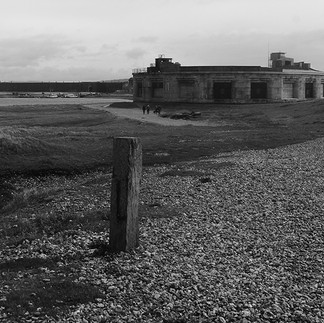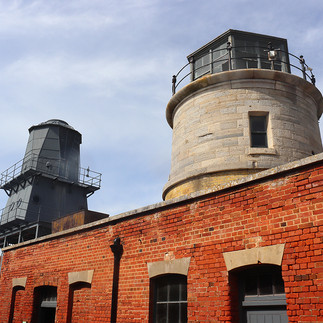The Device Forts - part 2
- jochengielen
- Oct 14, 2022
- 5 min read
Updated: Nov 2, 2023
Number 2: Deal Castle

Deal is located between Dover and Ramsgate, it is the middle castle of 3 very similar castles built at equal distances from each other, with the lost Sandown castle to the North and Walmer Castle to the South. All 3 were built to protect the relatively flat part of the coast against a French invasion, mainly Deal Beach where fishing boats operated, but also to defend the Downs anchorage when needed, they became known as "The castles of the Downs".

Deal castle was finished by 1540 and consists of a central keep surrounded by 6 inner and outer bastions, one of which houses the gatehouse, a dry moat surrounded the castle and there was a draw-bridge at the entrance. Deal castle had a low profile when looking at it from the sea, making it hard to hit by enemy cannons. Deal remained armed and ready throughout the reign of Queen Elizabeth I because of possible hostile actions by the French or the Spanish. In the early 1600's England was at peace and the castle was although still manned, in a terrible state with most of the men on duty actually living in the town and only a few guards being present in the castle at night. Some basic repairs were done in the late 1630's but overall the castle remained as it was and by 1642 it was captured by Parliamentarian forces in the First English Civil War, that was the only role it played during this war. In the Second English Civil War in 1648, all 3 castles declared Royalist but eventually surrendered to the Parliamentarians. Deal Castle remained an important military asset in the following wars but was also adapted to be more comfortable as a living space for the commanding officer, just like Walmer Castle. By 1829 the castle was looking more like a private house than a fort and although still manned, the commanding position was more an honorary position than an active military role. In 1904 the War Office declared it no longer a military installation and although the commanding Captain still lived there, it was opened to the public whenever he was out. During the First World War, it didn't play a significant military role, however in the Second World War the castle was hit by German bombers and the added housing block for the Captain was destroyed and some gun positions were installed in front of the castle, the castle itself served as a Battery Operating Post while the Captain was housed outside the Castle. Captain Birdwood died in 1951 and the castle officially ceased to be a residence, it was handed over to the Ministry of Public Building and Works. It is now a Scheduled Monument and operated by English Heritage (https://www.english-heritage.org.uk/visit/places/deal-castle/), open to the public.
I have personally visited this castle a few times and made several photos every time as can be seen below:
Number 3: Hurst Castle

Hurst Castle is a different story, this was the first line of defense against any hostile ship trying to get into the Solent from the Western passage through The Needle. The castle was, like most others built with a central keep surrounded by 3 circular bastions. It was built between 1541 and 1544 on the Hurst Spit and was intended to work closely together with another castle located across the shipping channel on the Isle of Wight.

Hurst Castle was one of the most powerful castles along the Southern coast of England in when completed. During the English Civil War the castle was held by Parliament and was even used to detain King Charles I before he was executed. After the wars it remained in use but the area was used by smugglers and the castle deteriorated to the point that in 1793 records say that it was in the worst condition of all coastal forts and the guns couldn't even be used anymore ... now what good is a gun that can't shoot? By the Revolutionary and Napoleonic Wars, repairs were made and the castle was modernized to enable it to use new 24-pounder guns, around this time there was a new coastal defense program underway, this included some of the old castles of the Device Forts as well and Hurst was one of them, the new Fort Albert was also built in this period on the Isle of Wight to provide cover fire when needed. However, the biggest change would come in the 1850's when new gun batteries were built on both sides of the castle, making the original castle now only a part of the modernized castle, the new batteries were built to house modern 32-pounder guns. Even this proved quickly outdated and by 1861, two huge granite batteries were built either side to provide 61 gun positions with newer heavy guns like the 12.5 inch rifled muzzle-loading gun, this was also the time when the original moat was filled in and disappeared.

In 1860 the 2 new lighthouses were also built, the lower lighthouse was built in the land-facing wall of the castle and the higher lighthouse outside the castle, both are still there today with the higher lighthouse still operational. Modernization continued when needed and this now massive coastal defense fortress was part of the network to protect the Solent during World War 1 when the Fire Command Post was housed in the newer Needles Battery and the guns were removed from the old castle, leaving Hurst with quick-firing modern guns. By 1933 the fort was passed into the National Collection of the Ministry of Works, the lower lighthouse had been replaced by a newer iron lighthouse in 1911 and this one is also still there although no longer in use. In World War 2 it was again re-armed and got more modern guns, more crucially by now were the Bofors anti-aircraft guns and 2 powerful searchlights as in these times the airplane formed a new threat. By the end of the war the castle was finally decommissioned and closed in July 1945. This was to be the last military action of the castle, being in use from 1544 until 1945. The castle was later transferred to the Ministry of Works and in 1983 taken over by the newly formed English Heritage (https://www.english-heritage.org.uk/visit/places/hurst-castle/). Today the castle is visited by 40.000 people every year. In 2021 part of the granite seawall collapsed and the area around it was closed off, plans are underway to repair this damage and protect the castle from coastal erosion.
I have visited the Hurst Spit several times, however in April 2022 I finally visited the castle itself, photos can be found below.










































































































Comments